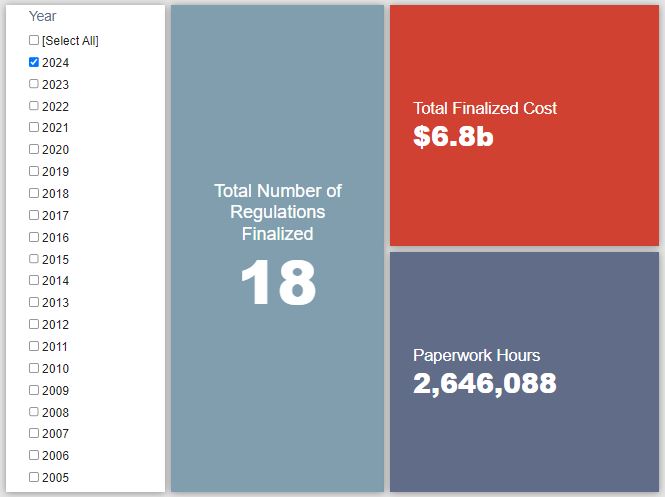Week in Regulation
January 22, 2024
Efficiency Is the Name of the Game During Short Week
With a shorter workweek on account of the holiday, last week had an abbreviated volume of rulemakings but did not lack in terms of substance. There were, like the week preceding it, only eight rulemakings with some quantifiable economic impact. A pair of energy efficiency rules from the Department of Energy (DOE) stood out as the main items. Across all rulemakings, agencies published $9.4 billion in total costs and added 2.3 million annual paperwork burden hours.
REGULATORY TOPLINES
- Proposed Rules: 23
- Final Rules: 45
- 2024 Total Pages: 3,868
- 2024 Final Rule Costs: $6.8 billion
- 2024 Proposed Rule Costs: $4.7 billion
NOTABLE REGULATORY ACTIONS
The most consequential actions from a cost perspective were the two energy efficiency rulemakings – one proposed, the other final – from DOE. The finalized one concerns “Energy Conservation Standards for Refrigerators, Refrigerator-Freezers, and Freezers,” and brings an estimated $5 billion in total “Incremental Product Costs.” The proposed one focuses on “air circulating fans (‘ACFs’) and fans and blowers that are not ACFs, which are referred to as general fans and blowers,” and brings $3.2 billion in total costs.
Of note, the refrigerator rule comes as a “direct final rule” that DOE could potentially be forced to withdraw if the agency “determines that any comments received provide a reasonable basis for withdrawal of the direct final.” The rule, however, essentially incorporates the consensus standards that “were proposed in a letter submitted to DOE jointly by groups representing manufacturers, energy and environmental advocates, consumer groups, and a utility.” As such, it does not appear that DOE is terribly concerned about the potential for withdrawal of the rule.
TRACKING THE ADMINISTRATIONS
As we have already seen from executive orders and memos, the Biden Administration will surely provide plenty of contrasts with the Trump Administration on the regulatory front. And while there is a general expectation that the current administration will seek to broadly restore Obama-esque regulatory actions, there will also be areas where it charts its own course. Since the AAF RegRodeo data extend back to 2005, it is possible to provide weekly updates on how the top-level trends of President Biden’s regulatory record track with those of his two most recent predecessors. The following table provides the cumulative totals of final rules containing some quantified economic impact from each administration through this point in their respective terms.![]() The direct final rule on energy efficiency standards for refrigerators discussed above accounted for most of the $5.1 billion upswing in the Biden Administration’s final rule cost tally. Neither of the other administrations came close to matching such an increase. The most significant action from either was the Trump-era rule from the Department of Labor establishing that administration’s version of the joint employer standard that involved $390 million in costs. With this past week falling right before January 20, the above totals now fully account for each administration’s first three years in office. The Biden cost and paperwork totals currently outpace those under Obama by $180 billion and 90 million hours, respectively.
The direct final rule on energy efficiency standards for refrigerators discussed above accounted for most of the $5.1 billion upswing in the Biden Administration’s final rule cost tally. Neither of the other administrations came close to matching such an increase. The most significant action from either was the Trump-era rule from the Department of Labor establishing that administration’s version of the joint employer standard that involved $390 million in costs. With this past week falling right before January 20, the above totals now fully account for each administration’s first three years in office. The Biden cost and paperwork totals currently outpace those under Obama by $180 billion and 90 million hours, respectively.
TOTAL BURDENS
Since January 1, the federal government has published $11.6 billion in total net costs (with $6.8 billion in new costs from finalized rules) and 4.6 million hours of net annual paperwork burden increases (with 2.6 million hours in coming from final rules).










